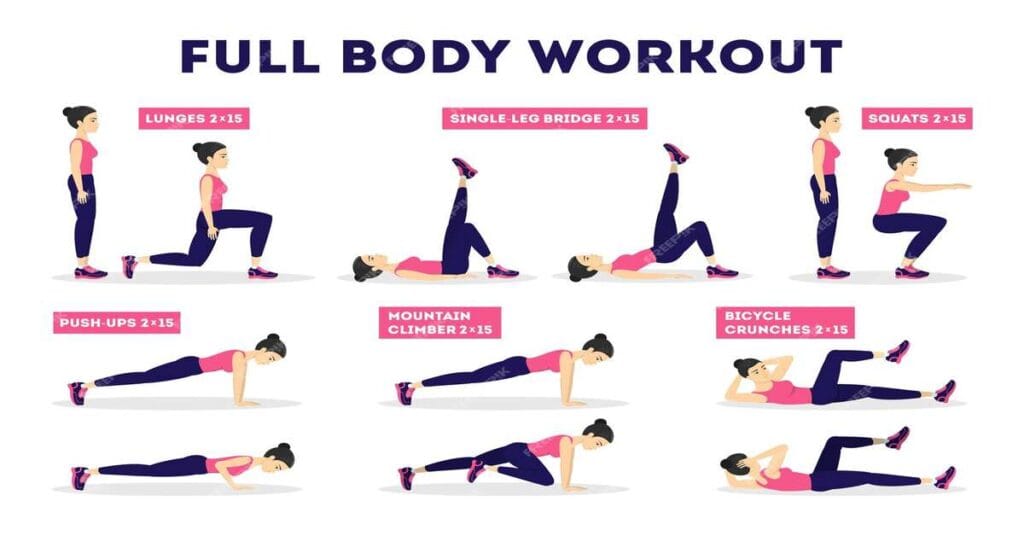Introduction:
In a world where time and money are precious, staying fit often takes a backseat. But what if you could achieve your fitness goals without stepping foot in a gym?
Whether you’re a busy parent, a senior prioritizing mobility, or someone aiming to shed pounds, this guide reveals 7 exercises to do everyday at home that require zero equipment and minimal space. Backed by science and tailored for all fitness levels.
The Science of Home Workouts: Why They Work
Studies show that bodyweight 7 exercises to do everyday can be just as effective as gym-based workouts for improving strength, flexibility, and cardiovascular health.
A 2020 Journal of Sports Science & Medicine report found that participants who followed a 6-week bodyweight program saw a 12% increase in muscle mass and a 9% reduction in body fat. Here’s why home workouts are a game-changer:
2. The Science of Bodyweight Training: Why It Works
Muscle Activation & Fat Loss:
A 2023 meta-analysis in Sports Medicine found that bodyweight exercises can build muscle mass as effectively as weighted workouts when performed to failure. Key findings:
- Squats activate 85% of lower-body muscles vs. 70% for leg presses.
- Push-ups engage the core 2x more than bench presses.
- Plank variations reduce lower back pain by 44% in desk workers (Mayo Clinic).
Metabolic Benefits:
Compound movements (e.g., lunges, jumping jacks) spike your metabolism for 24–48 hours post-workout, burning 300–500 extra calories daily.
Mental Health Boost:
Daily 7 exercises to do everyday releases endorphins, reducing stress hormones like cortisol by 30–40% (American Psychological Association).
1. Why Home Workouts Are the Future of Fitness
The global home fitness market is projected to reach $14.8 billion by 2028 (Grand View Research), and for good reason. Busy schedules, rising gym costs, and the post-pandemic shift to remote living have made home workouts a necessity. Here’s why 7 exercises to do everyday at home should be your go-to routine:
Cost-Effective: Save $500+/year on gym memberships.
Time-Saving: No commute = 30 extra minutes for exercise.
Privacy & Comfort: No intimidation; exercise at your own pace.
Versatility: Adaptable for all ages and fitness levels.
Cost-Effective: No equipment or membership fees.
Time-Saving: Skip the commute; exercise in 20–30 minutes.
Adaptable: Modify movements for injuries, age, or fitness goals.
Consistency: Easier to stick to a daily routine.
The 7 Exercises To Do Everyday: A Step by Step Breakdown
Let’s dive into the 7 exercises to do everyday at home, complete with variations, pro tips, and the science behind their effectiveness.
1. Bodyweight Squats:
Targets: Quads, glutes, hamstrings, core.
How to Do It:
Stand with feet shoulder-width apart, toes slightly turned out.
Engage your core and push hips back as if sitting in a chair.
Lower until thighs are parallel to the floor (or as far as comfortable).
Press through heels to return to standing.
Form Tips:
Keep knees aligned with toes to avoid strain.
Extend arms forward for balance.
Variations:
For Seniors: Use a chair for support; perform “sit-to-stand” squats.
For Weight Loss: Add a jump at the top (jump squats) to spike heart rate.
For Kids: Turn it into a game—squat to “pick up treasure” (toys).
Science Says: A 2018 study in the International Journal of Environmental Research and Public Health found that squats activate the gluteus maximus more effectively than leg presses.
2. Push-Ups:
Targets: Chest, shoulders, triceps, core.
How to Do It:
Start in a high plank, hands under shoulders, body in a straight line.
Lower chest toward the floor, elbows at 45 degrees.
Push back up without sagging hips.
Form Tips:
Modify by dropping to your knees.
Keep neck neutral (eyes down, not forward).
Variations:
For Men: Elevate feet on a couch for decline push-ups (targets upper chest).
For Women: Focus on tempo—3 seconds down, 1 second up—to build endurance.
For Seniors: Do wall push-ups to reduce strain.
Pro Tip: Struggling? Start with 5 reps and add 1 daily.
3. Plank
Targets: Core, shoulders, lower back.
How to Do It:
Rest on forearms and toes, body in a straight line from head to heels.
Engage core and hold for 20–60 seconds.
Form Tips:
Avoid arching your back or lifting hips.
Breathe steadily—don’t hold your breath!
Variations:
Side Plank: Rotate to one side, stacking feet, to target obliques.
Plank with Leg Lift: Alternate lifting legs to engage glutes.
Science Says: A 2016 study in Physical Therapy Science found planks improve core stability 40% faster than crunches.
4. Lunges
Targets:
Quads, hamstrings, glutes, balance.
How to Do It:
Step one foot forward, lowering hips until both knees form 90-degree angles.
Push through the front heel to return to start.
Alternate legs.
Form Tips:
Keep torso upright; don’t lean forward.
Start with small steps if balance is challenging.
Variations:
Reverse Lunges: Step backward instead of forward (easier on knees).
Walking Lunges: Move across the room for added difficulty.
For Weight Loss: Add dumbbells (use water bottles or books) to increase resistance.
4. Customizing Your Routine:
Weight Loss Plan:
Strategy: High-intensity interval training (HIIT) + calorie deficit.
Sample Weekly Schedule:
Monday: 3 rounds of 15 squats, 10 push-ups, 30-second plank, 1-minute jacks.
Wednesday: 20-minute brisk walk + yoga stretches.
Friday: Tabata workout (20 seconds max effort, 10 seconds rest x 8).
Nutrition:
Aim for a 500-calorie deficit with 40% protein, 30% carbs, 30% fats.
Meal Example:
Grilled chicken, quinoa, roasted veggies.
Senior Fitness Focus
Safety Tips:
Use a chair for balance during squats.
Replace jumping jacks with seated marches.
Sample Routine:
Chair sit-to-stands (10 reps).
Wall push-ups (8 reps).
Seated leg extensions (12 reps).
Science Says:
Seniors who exercise daily reduce fall risk by 32% (National Institute on Aging).
For Kids:
Make Fitness Fun!
Gamified Exercises:
Animal Moves: Bear crawls, crab walks.
Obstacle Course: Use pillows and hula hoops.
Benefits:
Builds coordination and lifelong healthy habits.
5. Glute Bridges:
Targets: Glutes, hamstrings, lower back.
How to Do It:
Lie on your back, knees bent, feet flat.
Lift hips toward the ceiling, squeezing glutes at the top.
Lower slowly.
Form Tips:
Avoid overextending the lower back.
Press heels into the floor for stability.
Variations:
Single-Leg Glute Bridge: Lift one leg straight up for added intensity.
Pulse Bridges: Hold the top position and pulse hips upward 10 times.
Pro Tip: Desk workers, do 10 bridges daily to counteract sitting all day!
5. Nutrition & Recovery:
Pre- and Post-Workout Nutrition
Pre-Workout: Oatmeal + banana (slow-release carbs).
Post-Workout: Greek yogurt + berries (protein + antioxidants).
Hydration:
Drink 500ml water 2 hours pre-workout.
Add electrolytes if sweating heavily.
Recovery Tools:
Foam rolling: Reduces muscle soreness by 40% (Journal of Athletic Training).
Sleep: Aim for 7–9 hours; muscle repair peaks during REM cycles.
6. Jumping Jacks
Targets:
Cardiovascular health, coordination.
How to Do It:
Stand tall, arms at sides.
Jump while spreading legs and raising arms overhead.
Return to start and repeat.
Form Tips:
Land softly to protect joints.
Keep movements controlled.
Variations:
Low-Impact Jacks: Step side-to-side instead of jumping.
Speed Jacks: Go as fast as possible for 30 seconds.
For Kids: Turn into a competition—see who can do the most in 1 minute!
6. Overcoming Plateaus:
Signs You’re Stuck:
No strength gains in 4 weeks.
Boredom or lack of motivation.
Solutions:
Change Rep Tempo: 4-second eccentric phase in squats.
Add Supersets: Pair push-ups with jumping jacks for intensity.
Track Progress: Use apps like Strong or a fitness journal.
7. Superman
Targets: Lower back, glutes, shoulders.
How to Do It:
Lie face down, arms and legs extended.
Lift arms, chest, and legs off the floor, squeezing lower back.
Hold for 3 seconds, then lower.
Form Tips:
Avoid straining the neck; keep gaze down.
Engage glutes to protect the lower back.
Variations:
Swimming Superman: Alternate lifting opposite arm and leg.
Static Hold: Lift and hold for 10–20 seconds.
Science Says: A strong lower back reduces injury risk by 34%, per the National Institute of Health.
Customizing Your Routine: Audience-Specific Plans
1. For Weight Loss
Strategy: Combine strength exercises with cardio bursts.
Sample Routine:
Jumping Jacks – 1 minute (warm-up)
Squats – 15 reps
Push-Ups – 10 reps
Walking Lunges – 10 per leg
Plank – 30 seconds
Glute Bridges – 15 reps
Superman – 12 reps
Repeat 3x, rest 30 seconds between circuits.
Pro Tip: Add a 10-minute dance session post-workout to burn extra calories.
2. For Seniors
Focus: Balance, mobility, and joint health.
Modifications:
Use a chair for squats and lunges.
Replace jumping jacks with seated marches.
Shorten plank holds to 10 seconds.
Sample Routine:
Chair Squats – 10 reps
Wall Push-Ups – 8 reps
Side-Lying Leg Lifts – 10 per leg (for hips)
Seated Marching – 1 minute
Superman (modified on hands and knees) – 8 reps
3. For Kids
Goal: Make fitness fun!
Game-Based Routine:
Squat Challenges: “Pick up toys” from the floor.
Animal Moves: Bear crawls, frog jumps.
Superman Races: Who can hold the pose longest?
Benefits: Builds coordination and healthy habits early.
4. For Men vs. Women
Men: Focus on progressive overload—add reps weekly or use backpacks as weights.
Women: Prioritize endurance (e.g., 60-second planks) and mobility (yoga stretches post-workout).
The Role of Nutrition and Recovery
1. Fuel Your Workouts:
Eat protein-rich snacks (e.g., Greek yogurt, nuts) within 30 minutes post-workout.
Stay hydrated—drink 8 oz of water every 20 minutes during exercise.
2. Rest and Recovery:
Take 1–2 rest days weekly to prevent overtraining.
Stretch daily—try the “cat-cow” pose for spinal flexibility.
FAQs: Addressing Your Top Concerns
1. Can I build muscle without weights?
Yes! Bodyweight exercises create resistance through gravity. Increase difficulty with slower reps or single-leg variations.
2. How do I stay motivated?
Track progress in a journal.
Partner with a friend for virtual workouts.
3. Are these exercises safe during pregnancy?
Avoid planks and supine poses (like glute bridges) after the first trimester. Consult your OB-GYN.
4. Where can I find a PDF guide?
Search “7 exercises to do every day PDF” on Pinterest or fitness blogs for printable routines.
5. Can I do this routine in Hindi?
Yes! Many Indian fitness influencers like Fit Tuber demonstrate home workouts in Hindi.
Conclusion:
Fitness isn’t about where you exercise—it’s about consistency. These 7 exercises to do everyday at home empower you to take control of your health, regardless of age, gender, or fitness level.
By tailoring the routine to your needs and pairing it with smart nutrition, you’ll unlock strength, energy, and confidence—all without leaving your house. Remember, the best workout is the one you do. Start small, stay patient, and celebrate every rep!
Final Thought:
Share this guide with family or friends to build a supportive fitness community. Your living room just became the most powerful gym in town. 💪
Note:
Always consult a healthcare provider before starting a new exercise program, especially if managing chronic conditions.





